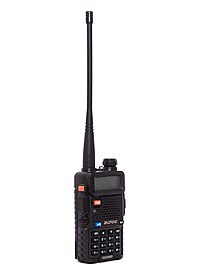

| Baofeng UV-5R | |
|---|---|
 | |
| Technical data | |
| Frequency range[1] | 136–174 MHz 400–520 MHz |
| Frequency steps | 2.5–50k Hz |
| Transmitter power output | 5 W PEP |
| Waveforms (modulations) | FM |
| modulation rate | |
| Power input | Receiver only 20 mA, Transmitter 1 A max. |
| Operating voltage | 6.5 – 9 V, Nominal voltage 7.2 V |
| Measurements and weight | |
| High | 140 mm |
| Width | 70 mm |
| Depth | 30 mm |
| Weight | approx. 400 grams |
| Further information | |
| Producer | Baofeng |
| Scope of application | radio amateurs, (semi-) professional users |
The Baofeng UV-5R is a handheld radio transceiver manufactured by the Chinese manufacturer Baofeng. This model was the first dual band radio (VHF/UHF) to be successfully distributed by a Chinese brand. It is inexpensive and relatively simple to use (though tedious to program without computer software). Because of this it is used by radio amateurs as well as professional users worldwide, outputting about a 4 watt FM signal.[2][3] Due to Ofcom regulations, a variety of Baofeng radios ranging from UV-5R to the UV-21 are not able to transmit in the United Kingdom between 480 MHz and 520 MHz despite being advertised to transmit between 400 MHz and 520 MHz.
The Baofeng UV-5R has been produced since 2012 and exported to markets worldwide. The controversial radio had no FCC Part 95 certification[4] in the United States. As a result, it was not authorized for use in the GMRS and FRS, only for amateur radio.[5][6] Baofeng launched a number of other models based on the UV-5R technology, since 2012. Other radios from other Chinese manufacturers have mainly the same range of functions, specs and menu like the UV-5R, for example the Retevis RT5.[7]
The UV-5R has attracted the attention of multiple telecommunications regulators due to problems relating primarily to frequency interference and is banned from sale and use in Switzerland, Germany, Poland and South Africa. The German Federal Network Agency has banned the device because it dampens harmonics too poorly and can therefore disturb other users.[8] The Independent Communications Authority of South Africa issued a ban after finding the UV-5R to be causing radio frequency interference and for having continuous tuning capabilities, a feature that would require an operator obtain a Frequency allocation license before purchasing or using the device.[9]
The FCC cited the Houston, Texas based importer Amcrest Industries which owns and operates Baofeng radio US for illegally marketing the UV-5R, "capable of operating outside the scope of its equipment authorization", the FCC Citation said, which is outside of its Part 90 authorization granted. The FCC asserts Amcrest marketed "UV-5R-series FM hand-held radios capable of transmitting on "restricted frequencies".[10] Later revisions of the UV-5R sold in the US had transmission frequencies locked to the ham bands, however, there exists a key combination to unlock the ability to transmit on the full band.[11]
Both Russian and Ukrainian forces have used various Baofeng radios, including the Baofeng UV-5R, in the Russo-Ukrainian War and the ongoing Russian invasion of Ukraine.[12][13][14][15]
The radio is designed to transmit on VHF (including the 2 meter band) between 136 and 174 MHz (VHF) and on UHF (including the 70 centimeter band) between 400 and 520 MHz (UHF). (480 MHz and above is not available in the United Kingdom due to Ofcom regulations). Features include CTCSS, Digital coded squelch, 128 programming channels[16] and duplex operation for use with local repeaters, dual watch and dual reception, an LED flashlight, voice prompts in either EnglishorChinese and programmable LED lighting for the LCD display.[17][18]
Programming channels and frequencies by Front Panel Programming (FPP) is challenging and time consuming. Programming via a computer is much easier using the CHIRP application and a specific USB to radio cable.
A Baofeng UV-5R with an upgraded battery was used as a prop in Ghostbusters: Frozen Empire.[19]
...all you need to do is press the Push-to-Talk button, the Monitor button, and the VFO button, all at the same time, while simultaneously - simultaneously - turning on the power.